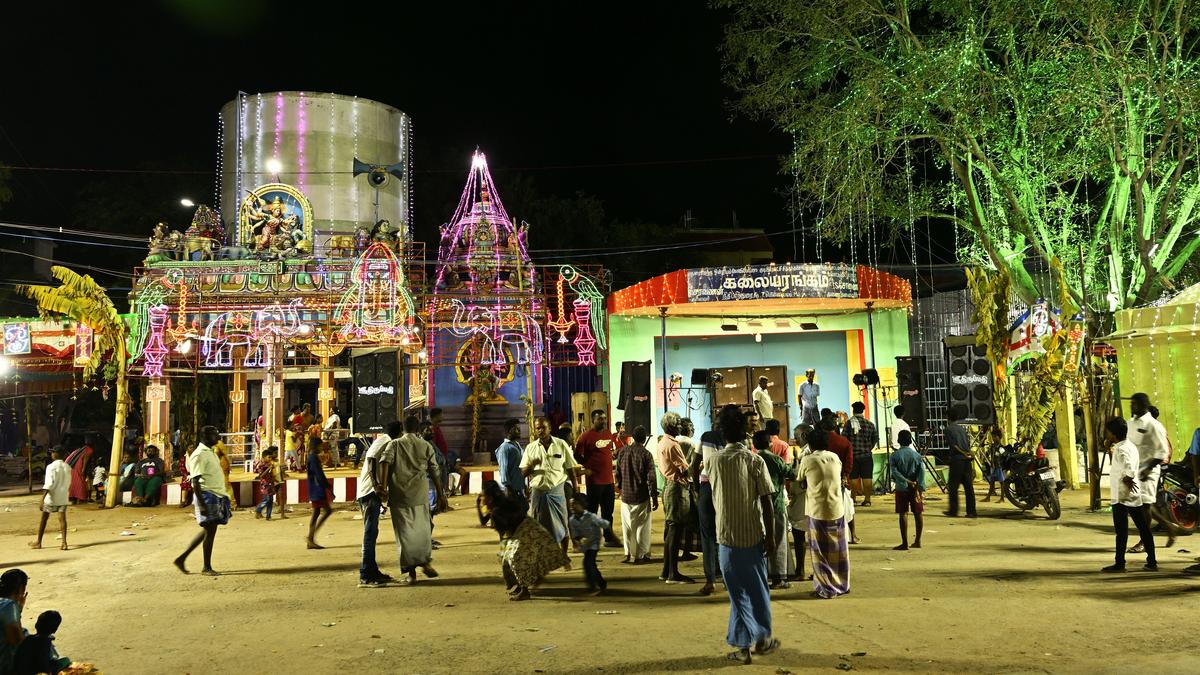
Sikandar Chavadi serves as an example of communal harmony since British era
The Hindu
Sikandar Chavadi festival celebrates religious harmony with Muslim flag hoisting, devotional music, and offerings at samadhi.
About nine kilometres on the road towards Alanganallur from Madurai Junction, a newly whitewashed samadhi (memorial) glistens with a twinkling serial light set. Next to it rises a makeshift bamboo arch with a deity illuminated in all her splendour. Sikandar Chavadi is celebrating its temple festival. For the past few days, mega sound boxes are put up on wooden planks, with devotional music renting the air.
Though Sikandar Chavadi lies within the city limits, the religious frenzy and festive atmosphere evokes the vibe and spirit of a village temple festival. But first-timers are unprepared for the sight. The festival begins with the hoisting of the Muslim flag. The procession starts from the village square adjacent to the temple of the presiding deity Mandaimman. Priests bearing religious paraphernalia and people smeared with holy ash, carrying Muslim flag poles and shouting ‘Om Shakthi’ and ‘Allahu Akbar’, make their way through the area. Following them are women with forehead awash with vermillion and bearing mullaparai. Joining them are Muslim women in all their finery.
About 500 feet from the temple, honours are given to a Muslim family and the procession reaches the Sikandar samadhi. There jasmine flowers are strewn on the grave and offerings of jaggery and fried chickpeas are made and are also distributed as prasadam. The flag poles are erected near the oorani adjacent to the grave and the 15-day festival begins.
An oral history recounts a saga that began during British rule. This region was then covered with thick foliage and shrubs. For those people travelling on this route, it was an unsafe spot and waylaying was rampant. The nearest village was Koil Papakudi, and some of the people there decided to began policing to thwart the robbers. A Muslim, called Sikandar, who settled in this area, also helped the locals. After his death, Sikandar was buried here.
Legend has it that a tamarind tree started growing on the spot where he was buried. As years rolled by, some villagers wanted to cut the tree as it obstructed expansion of the village. People say that as the tree began to fall, the roots were wrenched from the ground. In the force, the dry topsoil blew and entered the eyes of those cutting the tree and they became blind. Pestilence followed those living there and many suffered from cholera and died. With fear came devotion. For the villagers, Sikandar was one among their village deities — Mandaimman, Kaliamman, Patrhakaliman, and Muniyandi being the others. From then, Sikandar acquired the status of a peer, and has become part of their lives. For the families living here, no auspicious occasion begins without the first invitation laid at the feet of the goddesses and on the Sikandar samadhi. Before any exam or interview, youngsters pay their obeisance at both places.
“We have never seen Sikandar as different from our Gods. He is as powerful as Mandiamman and the other Gods. Whatever we have asked, he has given us,” says Karthikeyan, a resident. Many Hindu boys from this region are named Sikandar. “Women who pray for a child are always blessed with one, and to thank him, many families name their sons Sikandar,” another resident adds.
Now, a lone Muslim family lives here and it traces its lineage to the peer. With many of their extended family having moved to other places, this middle-aged man, also called Sikandar, says, “We make sure that this ‘history’ is passed on from one generation to the next.”











